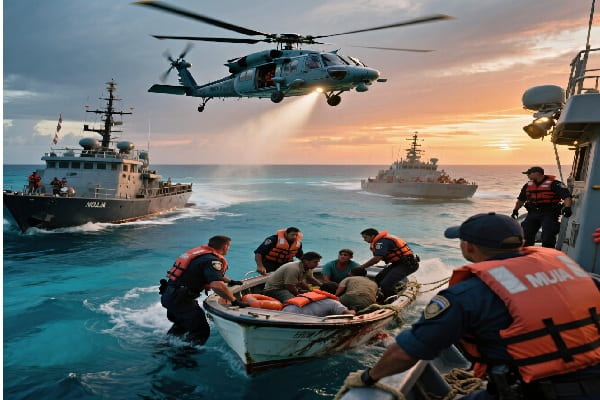If you’ve ever visited Isla Mujeres, you probably remember its powdery white beaches, turquoise waters, and vibrant coral reefs. On the surface, it feels like paradise—and it is—but just beyond the postcard views, another story unfolds. Out at sea, dedicated crews are carrying out ship interception operations that quietly protect both people and the marine environment.
These aren’t just routine patrols. They’re high-stakes missions that can mean the difference between life and death, often involving daring rescues and careful transfers to authorities. And here’s the thing: these efforts don’t just help those on the water—they keep the whole island community safer.
Let’s take a deep dive into why ship interception in Isla Mujeres matters, how it works, the challenges crews face, and how you can be part of it.
1. Why Rescues & Transfers Are a Lifeline at Sea
When a vessel in trouble is intercepted near Isla Mujeres, there’s no time to waste. The ocean is beautiful but unforgiving—every second counts.
-
Immediate response means people in distress get medical help faster.
-
Safe transfers to local authorities ensure rescued individuals are handled with care and according to protocol.
-
Streamlined coordination with law enforcement helps protect vulnerable individuals, especially in cases involving illegal trafficking or unsafe vessels.
These rescues do more than save lives. They build trust between locals, visitors, and the maritime teams—making people more likely to report suspicious or dangerous situations without hesitation.
2. How Ship Interception in Isla Mujeres Works
It’s not just a matter of spotting a boat and rushing in. Ship interception is a highly coordinated dance involving technology, skilled crews, and sometimes international cooperation.
Here’s what typically happens:
-
Detection – Suspicious vessels are spotted via radar, patrol sightings, or reports from fishermen.
-
Assessment – Authorities evaluate the situation, gathering intel on the vessel’s route and potential risks.
-
Deployment – Rescue boats with trained personnel head out, ready for anything from a medical evacuation to a law enforcement operation.
-
Interception – Crews board or approach the vessel, performing safety checks, offering assistance, and addressing emergencies.
-
Transfer & Follow-up – Rescued individuals are taken to shore and handed over to the right agencies for support or investigation.
Throughout, constant communication between all involved parties keeps the operation safe and efficient.
3. The Real-World Challenges Crews Face
Even with top-notch training, these teams deal with obstacles that would intimidate anyone.
-
Wild weather – Sudden tropical storms, strong winds, and unpredictable currents can turn a routine interception into a fight against nature.
-
Navigational hazards – Reefs and shallow waters near Isla Mujeres demand expert maneuvering.
-
Communication barriers – Language differences and limited tech in certain situations can slow down operations.
-
Emotional toll – Rescuers often encounter traumatic situations, from injured passengers to dangerous smugglers.
-
Budget limitations – Not every team has access to the latest boats or rescue equipment, making their job even harder.
Yet despite these hurdles, crews show up every day, ready to respond at a moment’s notice.
4. Success Stories That Inspire the Community
For every challenge, there’s a moment of triumph that reminds everyone why these missions matter.
Local fishermen often play the role of unsung heroes, being the first to notice vessels in trouble. Their quick actions can set the stage for successful rescues.
Every saved life strengthens the bond between residents and maritime teams. Stories of successful interceptions spread through the community, inspiring workshops, training programs, and safety awareness campaigns.
And perhaps most importantly, these rescues spark hope. They inspire young islanders to volunteer, learn maritime safety, or even build careers in rescue operations or environmental protection.
5. Why Ship Interception Protects More Than Just People
While the main goal is saving human lives, ship interception also safeguards the marine environment.
By stopping illegal fishing, preventing oil spills from unsafe vessels, or intercepting boats dumping waste, these operations help keep Isla Mujeres’ waters clean and its reefs healthy—a win for tourism, local livelihoods, and the planet.
6. How You Can Support These Efforts
You don’t have to be out on the water to make a difference. Here are some real ways you can help:
-
Donate – Even small contributions help fund fuel, safety gear, and training.
-
Raise awareness – Share stories of rescues and maritime safety on social media.
-
Volunteer – Many local groups welcome help with logistics, events, and public outreach.
-
Advocate for stronger policies – Support regulations that enhance maritime safety and environmental protection.
Every bit of involvement counts. The stronger the community support, the more effective the crews can be.
Also Read : Denver Nuggets vs Timberwolves Match Player Stats
7. The Big Picture: Why It Matters for Isla Mujeres’ Future
Ship interception may not be something tourists see, but its impact touches everyone. It ensures the island stays a safe haven—not just for beachgoers but for anyone navigating its surrounding waters.
With climate change increasing extreme weather events and shifting migration patterns, these missions will only become more important in the years ahead.
Final Thoughts
The ship interception efforts in Isla Mujeres are a testament to courage, teamwork, and a deep respect for life—both human and marine. They prove that when a community comes together, it can face challenges far bigger than itself.
Whether you live here, visit once a year, or are just learning about these operations for the first time, know this: you can be part of the solution. Support the crews, spread the word, and help keep the waters around Isla Mujeres safe for everyone.
Because behind every rescue is not just a saved life, but a stronger, safer community.

